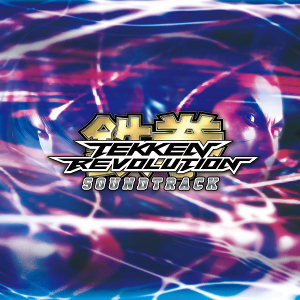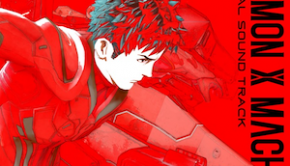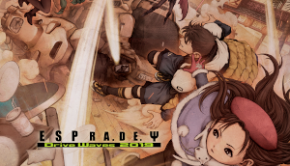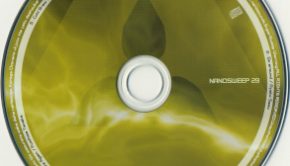Tekken Revolution Soundtrack
 |
Album Title: Tekken Revolution Soundtrack |
| Record Label: Sweep Record |
|
| Catalog No.: SRIN-1135 |
|
| Release Date: March 30, 2016 |
|
| Purchase: Buy at CDJapan |
Overview
The Tekken Revolution Soundtrack accompanies the free-to-play Playstation 3 downloadable game of the same name. Lead composer for the title, Taku Inoue, is joined by Namco composers, both past and present, including Rio Hamamoto, Shinji Hosoe, Hiroyuki Kawada, Ayako Saso, Hiroshi Okubo, Yuu Miyake, Nobuyoshi Sano, Yoshihito Yano, and Keiki Kobayashi, to present a soundtrack featuring plenty of electronic styles. How does the soundtrack turn out for this rendition of the fighting series?
Body
Inoue’s tunes provide a varied approach to the electronic styles heard on the album. “New World Order” starts off the album on the right foot with its exhilarating blend of guitar percussion hits. The “chorus” of the tune is quite beautiful, injecting some of Inoue’s softer styles into the mix, with its vocal sampling and mixing of electronic elements with a more Spanish inspired guitar line. On the flip side, “Blood, Sweat, and Fists,” is an electronic tune with lots of synth manipulation, some vocal samples, but it’s a tune that doesn’t really stand out, but, as a character select music, it isn’t the worst I’ve heard. His ending theme, “Night Rises,” carries along the tradition of recent Tekken outings by featuring rock elements blended with electronic elements. While this one isn’t lyrical, there are some vocal samples heard that help give it a delicate air and the layering of the rock and electronic elements makes for a tune with lots of depth.
As for his stage themes, I think he does a great job varying his approach as well, even if all the tunes aren’t exactly a home run. “Bassamenco” wonderfully utilizes Spanish elements, mainly in the form of a flamenco guitar, and combines them with a EDM approach. The beat and synth tones are quite nice, but it isn’t as varied as some of his other contributions on the soundtrack. “Francoise’s Bassline,” on the other hand, is my favorite Inoue theme. In terms of approach, it offers a smooth sound, with its acoustic guitar and intriguing bass line. There is also a “drop” that takes elements of dubstep and drum n’ bass that helps give it a bit more of a smooth sound by not being as harsh as some other tunes that incorporate these elements. “Lost in a Station” is one of the softer tunes on the album with its ethereal synth, acoustic guitar, and delicate electronic sounds. The end result is quite beautiful. On the other end of the spectrum, “Q” is dark, experimental, oppressive in nature, and very minimalist in focus, featuring a heavy utilization of percussion. It certainly is the outlier in terms of not incorporating a lot of heavy beats, but it does break up the heavy electronic dance focus of the album. Lastly, “Kodama Starship,” features an uplifting synth soundscape and is fairly enjoyable. The use of vocal samples helps accentuate the uplifting sound, although, like some of his other tunes on the soundtrack, might wear its welcome a bit thin.
The other major contributor to the album is Rio Hamamoto. Offering four tunes, his contributions are a bit gritter, blending electronic and rock elements primarily. “Self destruct” is one such tune featuring a nice blend of bass guitar and industrial tones that complement a pretty catchy melody as well. “Chopper” focuses a lot on slap bass in conjunction with a fast tempo and manipulated vocal samples, while featuring dubstep and rock elements. In my opinion, Hamamoto’s highlight tune is certainly “Offshore oil” featuring a rocktronic approach focusing on heavy beats and a gritty sound. The melody itself is quite memorable and the heavily processed vocal samples help add a bit of an industrial flair to the tune. His last contribution, “Brasil evolution” is a fun tune, but might not be for everyone. The processed vocals in this tune are extremely high pitched, which might put off some people, but the drum n’ bass backbone makes for an exhilarating listen nonetheless.
The rest of the music is done by a variety of artists, who each contribute a single track to the album. Hiroshi Okubo’s “Everlasting Heaven,” is a Ridge Racer meets dubstep sound, but also features some drum n’ bass influence. Some light synths and guitar also bring a bitt of contrast to the tune. Yuu Miyake’s “El Condor,” is quite unique, focusing on a percussion heavy approach with lots of modulated synths and bass. It’s quite rhythmic and intricate and veers away from the EDM aspect of a lot of the album, offering something quite fresh and unique, comparatively. “wHITe,” by Yoshihito Yano, is another highlight with its upbeat and bright synths, vocal samples, and catchy rhythm. sanodg’s (Nobuyoshi Sano) “Lunar fringe theories” is a more subdued piece of music with ethereal vocal samples and a soft synth texture and is very reminiscent of some of his music in Tekken Tag Tournament 2. “The ends of the eternal snow,” by Ayako Saso, features a very Saso-esque electronic beat, providing nothing out of the ordinary for the composer, but I do enjoy the catchy synth melody and the incorporation of harpsichord and dubstep elements during slower tempo sections of the tune. Hiroyuki Kawada’s “No Easy Way Out” features soft piano passages with energetic drum n’ bass inspired bass lines. The melody itself is quite nice and the overall tone would work well even in a spy/action thriller sort of setting. Keiki Kobayashi’s “Fight in the Netherlands” is very Tekken Tag Tournament 2 sounding and sounds inspired by AJURIKA. It is a bit one note however, but the subtle effects in the background give it a bit more complexity. His work on Street Fighter V, in my opinion, is far superior. Lastly, Shinji Hosoe’s “Fear to agonize,” is another crowdpleaser with its acoustic guitar meets heavy and deep beats. The fast tempo helps give it that fighting mentality and the overall direction of the tune is stellar, especially when the acoustic guitar gets to shine.
Summary
In the end, Inoue’s efforts, as well as his direction on the overall sound of the game’s music, help lead to a varied listening experience. While not every track manages to succeed entirely, the end result is still something that fans of modern Tekken music will enjoy. There are certainly plenty of styles to choose from and many artists put their best foot forward. With the Tekken 7 soundtrack right around the corner, it’ll be interesting to see how Rio Hamamoto, whose contributions took on a grittier approach, fares as sound director.
Do you agree with the review and score? Let us know in the comments below!
4
Posted on May 3, 2016 by Don Kotowski. Last modified on May 2, 2016.














